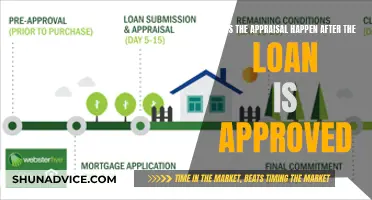
A loan estimate is a standardised document that outlines the key details of a mortgage application. It is provided by the lender within three business days of receiving a completed application. The estimate includes information such as the interest rate, monthly payment, and closing costs. It also indicates if the loan has special features, such as penalties for early repayment. The loan estimate is a useful tool for borrowers to compare different loan offers and understand the terms of their loan. However, it is important to note that the loan estimate is not a guarantee of approval or commitment to the loan. In some cases, the loan estimate may be subject to change due to various factors, and it is illegal for lenders to intentionally underestimate charges.
| Characteristics | Values |
|---|---|
| Number of pages | 3 |
| Page 1 | Summary of the loan, including loan term, purpose, product, loan type, rate lock, interest rate, and monthly principal and interest |
| Page 2 | Breakdown of individual estimated closing costs, including non-negotiable loan services and services the borrower can shop around for |
| Page 3 | Details of the mortgage agreement, including the names of the lender and loan officer, amount of loan principal paid off after the first five years, combined principal, interest and mortgage insurance costs, annual percentage rate (APR), and total interest percentage (TIP) |
| Standardization | All lenders are required to use the same standard Loan Estimate form |
| Timing | Lenders must send borrowers a Loan Estimate within 3 business days of submitting a completed mortgage loan application |
| Validity | A Loan Estimate is valid for 10 business days |
| Pre-approval | A Loan Estimate is not an official pre-approval |
| Changes to estimated charges | Lenders may increase the estimated charges in certain circumstances, such as changes to the kind of loan, reduction in the down payment amount, a lower-than-expected appraisal, changes to the borrower's credit score, or changes to the interest rate lock |

Higher interest rates
A loan estimate is a standardised document that outlines the key details of a mortgage application. It includes information such as the estimated interest rate, monthly payment, and total closing costs for the loan. Lenders are required to provide a loan estimate within three business days of receiving a completed mortgage loan application.
Additionally, the loan estimate will indicate whether the interest rate is fixed or adjustable. A fixed-rate loan means that the interest rate will remain the same throughout the loan term, while an adjustable-rate loan may have a variable interest rate that can change over time. Adjustable-rate loans often start with a lower interest rate than fixed-rate loans, but the rate can increase later on. Therefore, when reviewing loan estimates, it is important to consider not only the initial interest rate but also the potential for future rate adjustments.
Furthermore, the loan estimate will also detail any additional charges and fees associated with the loan. These may include origination charges, underwriting fees, application fees, and appraisal fees. Some of these fees may be negotiable or dependent on specific circumstances, such as choosing your own vendors or reducing the down payment amount. By understanding these additional costs, borrowers can make informed decisions about the overall affordability of the loan.
To summarise, higher interest rates can significantly affect the affordability of a loan. When reviewing loan estimates, borrowers should carefully consider the interest rate, whether it is fixed or adjustable, and any associated fees and charges. Comparing multiple loan estimates can help identify the most favourable terms and ensure borrowers obtain the best deal possible.
FDIC-Insured Savings and Loans: Are Your Finances Protected?
You may want to see also

Closing costs
In some states, you must get a land survey before completing a home sale, which can cost between $400 and $1,000. Additionally, you may be charged a recording fee of around $125 to update public land ownership records. A lender may also charge a fee to lock your interest rate, typically between 0.25% and 0.50% of your loan value.
The most cost-effective way to cover closing costs is to pay them out of pocket as a one-time expense. However, some lenders may allow you to finance them by folding them into the loan, but you will pay interest on those costs through the life of the mortgage. It is important to review your Loan Estimate carefully to understand all the fees and charges included in your closing costs.
Loan Discrimination: Are Consumers Protected?
You may want to see also

Monthly payments
A loan estimate is a standardised document that outlines the key details of your mortgage application. It is important to review the estimate carefully to ensure you understand the loan and can comfortably afford it. The loan estimate shows your projected monthly payments, interest rate, and annual percentage rate, among other details.
The monthly payment section of the loan estimate is particularly important as it gives you an idea of what your financial commitment will be each month. This section includes your monthly principal and interest, which is the amount you will borrow and the lender's charge for lending you the money. This is the main component of your monthly mortgage payment.
However, it is important to note that your total monthly payment will typically be more than this amount due to additional charges such as taxes and insurance. These additional charges are related to homeownership and may be bundled into your monthly payment. It is important to review your loan estimate carefully to understand all the charges included in your monthly payment.
The loan estimate also provides information about how the interest rate and payments may change in the future. For example, if you have an adjustable-rate loan, your monthly payments may increase or decrease over time as the interest rate changes. Additionally, certain circumstances, such as a change in your credit score or a lower-than-expected appraisal of the home, may result in the lender increasing the fees quoted in the loan estimate.
To ensure you are getting the best deal, it is recommended to compare loan estimates from multiple lenders. By reviewing the estimated total monthly payments and understanding the additional charges, you can make an informed decision about which loan offer is most affordable for your budget.
Education Department Loan Mail: What You Need to Know
You may want to see also

Loan affordability
When it comes to loan affordability, there are several factors to consider. Firstly, it's important to understand the difference between the principal and interest payments and the total monthly payment. The principal is the amount you will borrow, while the interest is the lender's charge for lending you the money. Your total monthly payment will typically include additional charges such as taxes and insurance.
To assess loan affordability, you need to consider your income, debts, and down payment. A lower interest rate can significantly lower your monthly mortgage payment. Your down payment amount can also impact the affordability of a loan. A larger down payment can lower your monthly payment, avoid private mortgage insurance, and increase your affordability. Lenders may also require private mortgage insurance if the down payment is less than 20% of the home purchase price.
The loan term, which is the amount of time you have to repay the loan, can also affect affordability. Shorter loan terms typically result in higher monthly payments but often come with lower interest rates. On the other hand, longer-term loans may have lower monthly payments but could result in paying more interest overall.
Additionally, there are other costs associated with homeownership that can impact loan affordability. These include property taxes, homeowner's insurance, HOA fees, and other fees such as mortgage insurance, flood insurance, or condominium fees. By using affordability calculators, you can input your financial information, such as income, debts, and down payment, to get an estimate of how much house you can afford and the associated loan costs.
Kidde Condo Loan: Still Available or a Thing of Past?
You may want to see also

Lender credits
However, it's important to understand that lender credits are not free money. They come at the cost of a higher interest rate on the loan. The more lender credits received, the higher the interest rate will be. This results in higher monthly payments and a greater amount paid over the life of the loan. For example, a borrower might save $500 on closing day with a lender credit but end up paying more than $10,000 extra in interest over a 30-year period.
The decision to accept lender credits depends on various factors. Borrowers should consider their future plans, such as whether they intend to refinance later or pay off the mortgage early. If a borrower chooses to refinance to a lower rate in the future, they may be able to mitigate the increased interest caused by the lender credit. Additionally, a good credit score and a substantial down payment can help in obtaining a favourable lender credit.
Tesla Loan Prepayment: Penalty or Peace of Mind?
You may want to see also
Frequently asked questions
A loan estimate is a standardised document that outlines the key details of your mortgage application. It includes information such as the estimated interest rate, monthly payment, and total closing costs for the loan.
You will receive a loan estimate within three business days of applying for a mortgage. By law, lenders must send borrowers a loan estimate within this timeframe.
A loan estimate includes information such as the loan term, purpose, product, loan type, interest rate, monthly principal and interest, and estimated total monthly payment. It also includes closing costs, or "settlement costs", which are the upfront costs you will be charged to get your loan and transfer ownership of the property.
A loan estimate can change under certain circumstances. For example, if you decide to change the kind of loan, reduce the amount of your down payment, or your credit score changes. It is illegal for a lender to intentionally underestimate charges and then surprise you with higher charges on a revised loan estimate.







